We learned last time that after Late Antiquity, art and culture and even religion began to veer off in different directions. The Byzantine Empire covered, generally, the East; today we discussed what was going on in the West, mostly in Europe. The two divisions, East and West, were not exclusive of each other, however; trade, travel, conquest, and cultural and diplomatic exchanges continued, informing art and architecture. I had no idea that Medieval Art could be so fascinating until these last few weeks.
In Western Europe, the "early Medieval" period followed Late Antiquity. Art in this period fused Greco-Roman culture, the influences of Christianity, and the cultural influences of the non-Roman people from the North of Europe. Political instability in the West led to the establishment of more independent territories and governments, and lots of movement and migration for conquest, exploration, and missionary work. Although Romans called everyone beyond the boundaries of the Roman Empire "barbarians," in fact there was power and sophistication in non-Roman cultures. In the early Medieval period we see the emergence of these cultures.
What survives of the art of the "Warrior Lords" are small, portable objects, probably status symbols, that have been found in elaborate burials. Think Beowulf, or even Lord of the Rings: the migration cultures tended to bury their dead with rich furnishings including jewelry and weapons. On occasion, entire ships full of objects would be buried with the dead. The jewelry and weapons of each culture are somewhat distinctive, depending on the values and history of individual cultures. Regional artistic styles did not develop in isolation, so we see similarities between the various cultures, and influences from Roman culture as well.
This is illustrated in this pair of fibulae on display at the Walters. The eagle was adopted from Roman imperial insignia and was a popular symbol during the Migration period, especially among the Goths. The shapes are abstract, representing the idea of an eagle instead of focusing on a naturalistic representation of nature. What mattered to migration culture, in this case the Visigoths, was the quality of the materials and the technical brilliance of the manufacture. These pins would have been worn together, one on each side, to hold a cloak. Pendants once dangled from the loops at the bottom. We can assume that these were proud possessions buried with their owner.
The Visigoths had been mercenaries in the employ of the Roman empire. When Rome declined, they moved West and eventually sacked Rome in 410. They moved on and settled in Spain, where they established trade and diplomatic contacts with the Byzantine Empire.
Another Migration culture represented at the Walters is the Hunnish culture. The Huns arrived on the scene in Western Europe in the wake of a weakened Roman Empire. Huns traveled and fought on horseback, and were renowned for their excellent horsemanship. The importance of the horse in Hunnish culture is demonstrated by this fine and rare set of horsetrappings.
The large piece is a chamfron, which was worn on the horse's head above the eyes. This one is ornamental rather than defensive and indicated the wealth and power of the horse's owner. The two thin strips are bridle mounts, which probably covered the bridle or reins near the horse's head, where they would be best displayed. The gold tube is the handle of a Hunnish whip, called a "nagaika." The open end held the leather of the whip, which would be secured in place by the bronze rivet. The Huns had no spurs and instead used these whips to urge their horses to run.
There is a lovely wall of cases at the Walters with jewelry and "furnishings" from several different Migration cultures.
Frankish tribes under Charles Martel began the process of consolidating their holdings into what would become a fairly large empire under Charlemagne. Martina moved from the Migration jewels to a case with some Carolingian ivories. When Charlemagne was named Holy Roman emperor in 800, he began a conscious revival of Roman art and culture which lasted for about 200 years. He used art as propaganda to establish his legitimacy and consolidate his power. Ivory carving was popular as a luxury art in the Roman Empire, so it was revived under Charlemagne and his successors. In keeping with the Classical underpinnings, the carvings revert to more naturalism, more depth, and more storytelling. This ivory book cover demonstrates this trend. At the top is the crucifixion, with the three Marys arriving at the tomb at the bottom. The frame is decorated with icanthus, a decorative floral motif that was popular in Roman times.
Charlemagne also had a great interest in books, including the Bible, and the work of scribes. Under his patronage, Latin again came to prominence, and a new script, Caroline miniscule, modeled on Roman inscriptions, was developed. Art depicting the four Evangelists became more common.
After Charlemagne's death, his empire broke up into weak kingdoms which were eventually consolidated under the Ottonians. The Ottonians preserved and enriched Carolingian culture, however, and continued to cultivate an interest in books. Treasure binding for books used during liturgical services became popular in the 11th and 12th centuries. This binding shows the four Evangelists in ivory, Christ in the center under rock crystal, and elaborate silver filigree suggesting teeming life. It is a rich example of Ottonian art.
Ivory was very popular during the Carolingian and Ottonian periods, as trade routes were re-established. This crosier, possibly made in Sicily in the thirteenth century, is made of ivory with a depiction of an eagle defeating a dragon, the symbol of evil. The eagle holds a book inscribed with abbreviated forms of the Latin words for "John" and "Evangelist," confirming that this is no ordinary bird, but a symbol of the Gospel author. The eagle turns his head to confront the dragon eye to eye - a depiction of the power of the Word of God to conquer evil. The piece is inset with colored glass, and there is evidence that parts of it were once set off with gold and paint.
John asked Martina to speak to us about the "oliphant" or ivory horn. Martina replied that oliphants were mysterious objects, and that the more we study them the less we know. This example is carved to retain the shape of the horn, and may have been used for drinking, for hunting, or just symbolically. Oliphants have been found hanging in churches, so may have been used as reliquaries. The designs on our oliphant show a mixture of Byzantine, Islamic and western motifs. At the very least the object testifies to a lively multicultural exchange.
Cheaper alternatives to ivory were sometimes used to get the look without the price. This delightful little chess piece, carved in Spain in about the 12th Century, is made of walrus tusk. The Queen is based on models from the Arab world, but her headpiece is typical of 12th C. Spanish royalty. She is shown looking out from her castle. The figure and the castle are depicted in the same scale, indicating their equal importance, something that would have been obvious to a medieval viewer.
Stepping into the next gallery we step into the Romanesque world. "Romanesque" is a term art historians invented to describe art that looked "Roman-like." It broadly designates history and culture of Western Europe from about 1050 - 1200. During this time there was a sharp increase in trade, and the growth of towns and cities led to the decline of feudalism. Towns and cities became the nuclei of networks of maritime and overland commerce.
Monasteries were separated from this hubbub. By the 9th Century, Benedictine rule, which emphasized work and prayer, was standard for most European monastic establishments. Monasteries were built to reflect this standard, and the architecture conformed to the needs of the religious orders. For the lay populace, Church buildings were remodeled or reconstructed to reflect a new emphasis on pilgrimage, and craftsmen (often monks) scrambled to fill them with glorious liturgical furnishings. Veneration of relics reached a high point in the 11th and 12 Centuries.
Martina directed us to this Reliquary Panel of the Triumphant Jesus, as an example of the sumptuous materials being used but also an example of the medieval trend of re-using and re-purposing older objects. This reliquary panel once formed one end of a reliquary chasse. It may have formed part of an altarpiece before being used in the chasse. Here the flat panel is outfitted with a frame to hold small relics. The use of precious metals, gemstones, and color was designed to transport the viewer to a higher realm.
During the medieval period, including the Romanesque period, there was a high level of emphasis on technique and craft and a low emphasis on creativity and design genius. An artist's "manual" from this time, written by "Theophilus, " emphasizes the craft and technology - building the furnace, grinding the glass, hammering the metals, getting the right temperatures for firing, for example - without mentioning the art of design. Many of the best craftsmen were monks, giving praise to God by the work of their hands.
One craft very difficult to do and therefore very valuable was enameling. Martina discussed the process of cloisonné, in which thin wires are laid on the surface of the metal to create cells to be enameled. She contrasted that technique with champlevé, in which the area to be enameled is shallowly carved from the metal to create chambers which are filled with color. This cross uses vivid and varied colors, especially white and red enamels, combined with technical details such as the delicate gilded metal outlines that shimmer with stippling (dotting). It is the work of craftsmen active at Grandmont Abbey, near Limoges, in central France.
Over time, metalwork and enamel boxes were made in workshops near monasteries, and began to be exported. Some parts were even used interchangeably, and multiple copies of similar works appear, indicating that styles traveled and hinting at serial production. This box demonstrates the use of separately manufactured heads applied to an enameled (in this case champlevé) background.
Martina suggested that workshops created "buckets" of pieces so that complete products could be pulled together relatively quickly. Martina noted that a huge amount of Limoges metalwork survives, meaning there must have been a great deal more at one time.
The revival of stonecarving is one of the hallmarks of the Romanesque age. The use of stone reliefs to decorate church portals became widespread in this period, but there was still resistance to the creation of statues in the round. An exception to that resistance was in the creation and use of wooden statues and statuettes of the Virgin Mary holding the Christ Child in her lap. This wooden sculpture of the Virgin and Child is typical of the Romanesque style. In order to convey the idealized, heavenly nature of the subject, the artist gave the holy figures compact, self-contained bodies covered by clinging, linear drapery. The statue is carved in the round, allowing it to be used both as a stationary, devotional object in a church and as a portable image, carried in procession on religious feast days. The Virgin has a hollowed-out back, possibly to contain a relic. Statues such as this are called "Thrones of Wisdom" as the Virgin, Mother of God, served as a throne for Christ, the incarnation (embodiment) of Divine Wisdom.
Eventually, the Romanesque era gave way to the Gothic. The term "gothic" began as a term of ridicule for late medieval art. Nevertheless, the Gothic style was all the rage in most of Europe in the 13th and 14th centuries, and was considered "modern work." Many great cathedrals were built in this exciting new style.
Gothic style first appeared in France in about 1140, at St. Denis. The new type of vaulting and the use of buttresses allowed churches to be built to soaring heights, with open walls that allowed for stained glass. Stonecarving became even more prominent and the carved figures became more naturalistic and more three-dimensional. The Walters has these stone heads of Old Testament kings salvaged from St. Denis that exhibit this more natural, more human style.
Another hallmark of Gothic architecture is the use of stained glass windows. The Walters has a fine example of a 13th century window taken from St. Germain-des-Pres in Paris and reassembled with some reconstruction.
The window is one of a pair depicting the life and martyrdom of Vincent of Saragosa. The scenes read from bottom to top: Vincent preaching; Vincent tortured by fire; a modern replacement; Vincent in prison; Vincent's soul ascending into heaven; Vincent's body protected from wolves by a raven; and Vincent's body being cast into the sea. The window commemorates St. Vincent's life and two of his relics-his tunic and his jawbone-given as royal gifts to the monastery.
Such windows would have typically been high up, and it would have been very difficult for laypeople to actually read the window. Still, the story would be talked about and known by a largely illiterate people. More importantly, the colored windows would fill the interior of Gothic churches with the lux nova or "new light" that would transport visitors to a higher realm.
Elaborate metalwork was still the rage and also would have been part of the Gothic effort to transport viewers. This gorgeous monstrance, designed to contain and display the "Host" [communion wafer], is a gorgeous example of metalwork and illustrates the medieval commitment to fine craftsmanship. The chamber is composed of rock crystal, loved by medieval craftsmen because its clarity suggested to the medieval mind that light and truth could pass right through it.
Metalwork was also used for altar frontpieces and to decorate the arms of a Cross. This image of a mourning Mary was probably made under the auspices of the Abbey of Grandmont, one of the most influential patrons of Limoges metalwork. Its partner is thought to be a piece in London at the Victoria and Albert museum.
This fragment of a large altar frontal is made from gilded copper and glass. It portrays part of Christ's sacrifice and passion and would have resonated with medieval viewers during the Eucharistic ritual performed at the altar.
Gorgeous liturgical vessels were in use and might have been donated by wealthy patrons. This lovely Limoges Eucharistic Dove was used for storing communion wafers. Doves such as this were suspended above the altar to signify the presence of the Holy Spirit at the Mass. On this fine, colorful example, the sparkling glass eyes and shimmering enamels on the wings and tail highlight the richness of the material of the liturgical vessel. The wafers were stored in a cavity under a hinged lid on the bird's back.
Reliquaries were still in use and were probably being made for export and sale without specific relics in mind. In general, reliquaries were developing to include more sculpture. Sometimes, they were made as "speaking" reliquaries, designed to describe the object within. This Arm Reliquary of St. Pantaleon is one example.
And devotional plaques were still in use for private devotions. This "opening Virgin," Vierge Ouvrante de Boubon, invites the viewer to contemplate a serene image of the human child Christ on the front, and then opens to reveal images of his death and resurrection. This version was first owned by the female priory at Boubon, southwest of Limoges, and other examples were also owned by female monastic communities. [In 1996, there was a bit of a scandal involving other examples of vierges ouvrantes which turned out to be fake. The Walters model was tested and found to date to the 13th century.]
Secular art was also produced in medieval times, and often invoked scenes of courtly love and romance. This particularly lovely casket is an example of works concerning the "Castle of Love" which sometimes depict assaults on a castle defended by lovely women, and may include other scenes from romantic stories. In the center of the lid of the Walters box, knights joust as ladies watch from the balcony; to the left, knights lay siege to the Castle of Love, the subject of an allegorical battle. The remaining scenes on the casket are drawn from well-known stories about Aristotle and Phyllis, Tristan and Iseult, and tales of the gallant, heroic deeds of Gawain, Galahad, and Lancelot.
There are many ivory objects in the Walters collection, including mirror covers and combs with similar scenes. Ivory carving was at its height in the 12th and 13th centuries.
John joined us in the afternoon to discuss how to use these medieval objects on school tours. The stained glass window can be used for telling stories in art, for example, and many objects could be used on a tour concerning materials used in the middle ages. There are three examples of the "seat of wisdom" Madonna that could make for interesting compare and contrast, and we could note the symbolism of colors used for images of the Madonna: Red, for the passion of Christ, blue, for Mary the Queen of Heaven, white for her purity, and gilt or gold for her majesty. Of course, the secular items such as the casket and mirror cover can be used as well.
Next week: International Gothic and Northern Renaissance.

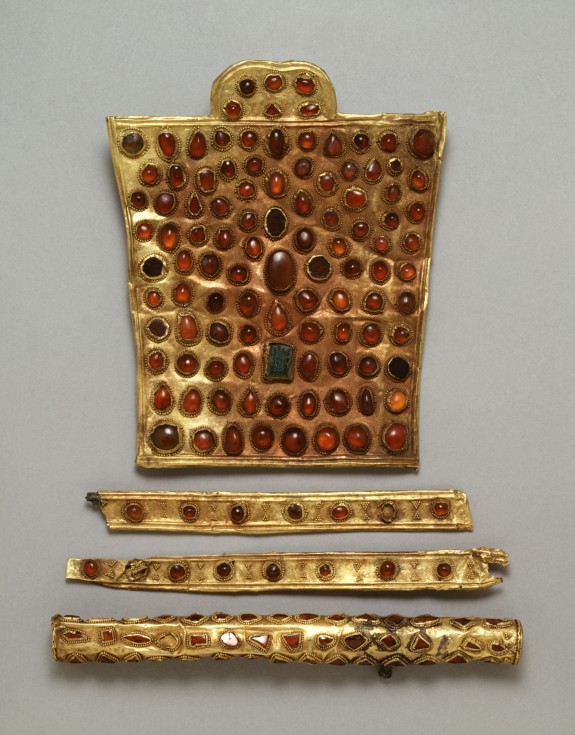
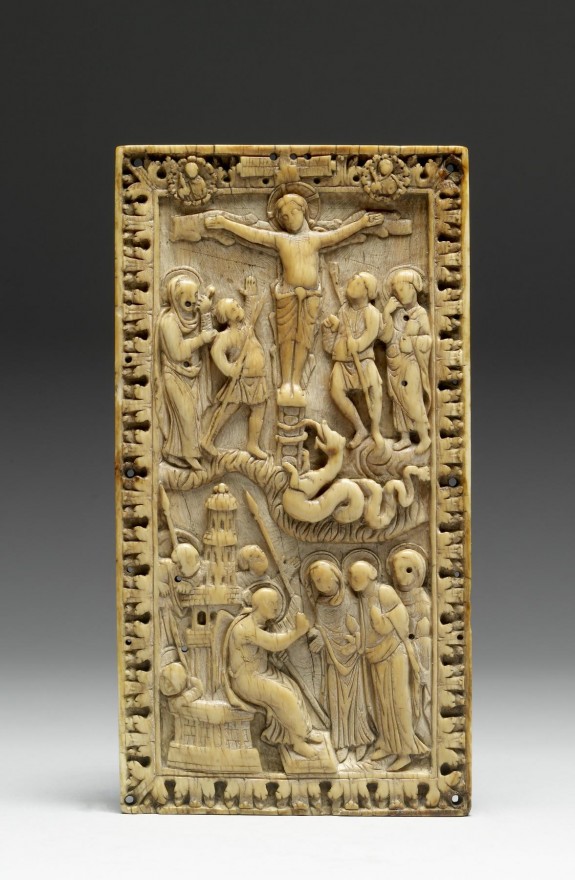
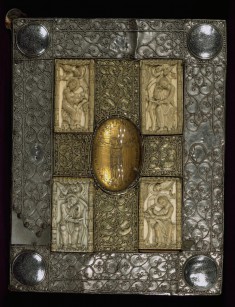
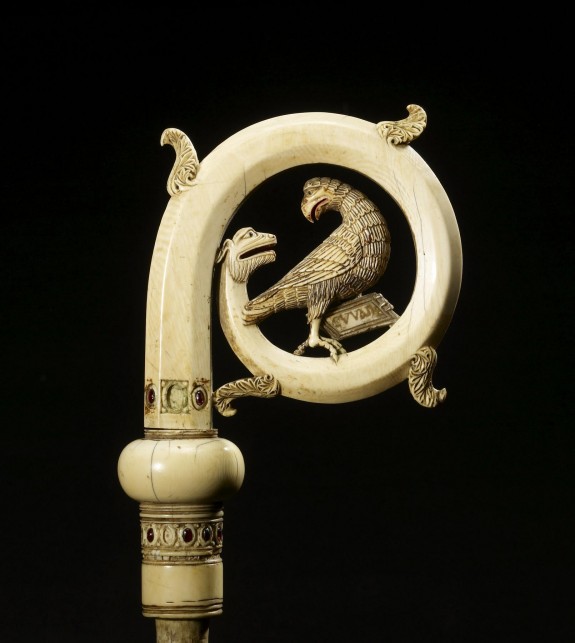


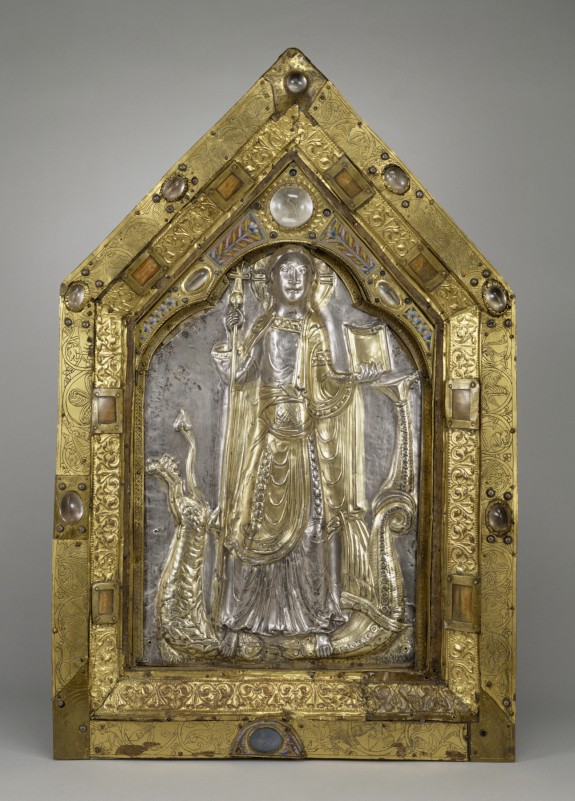


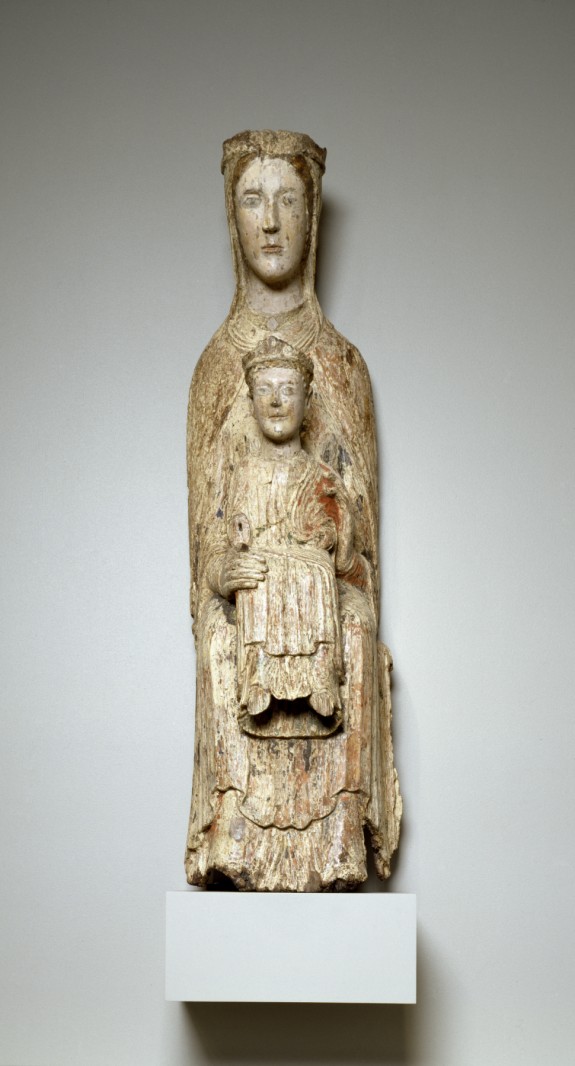











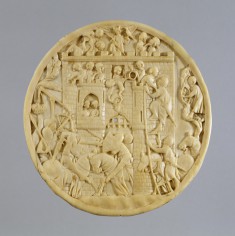
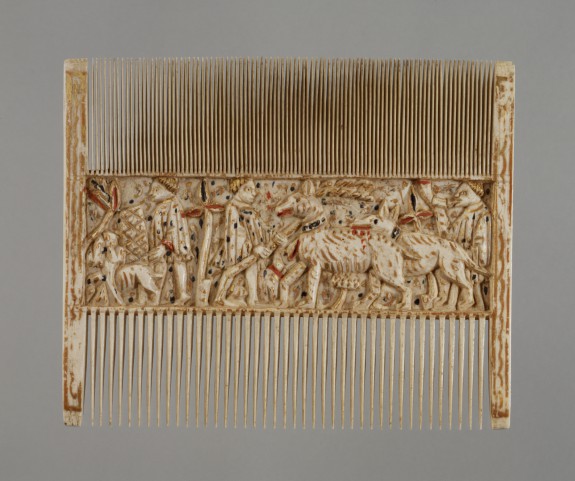
Loving the Oliphant! Very interesting - thanks for sharing
ReplyDelete